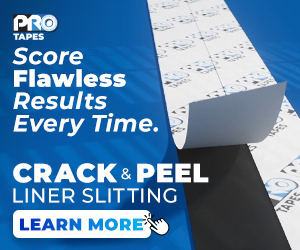Surface Energy Matchmaking
- Published: August 01, 2011, By By Mark Miller Contributing Editor
Typically, when you coat a fluid onto a substrate, the fluid flows to the limits of the coating head and provides a solid layer of fluid over the substrate. Sometimes, however, the fluid resists this reformation and coating defects occur.
Pinholes, ribs, and beading-up of the fluid are common when the fluid resists flow. These coating defects are an example of the fluid liking itself more than it likes the substrate.
 Because of the fluid's fondness of itself (chemically speaking, of course), the fluid contracts or beads up. We have all seen this — water droplets form on a window and don't want to wet out, so they form individual beads (see Figure 1).
Because of the fluid's fondness of itself (chemically speaking, of course), the fluid contracts or beads up. We have all seen this — water droplets form on a window and don't want to wet out, so they form individual beads (see Figure 1).
In the coating world, though, we need the fluid to like the substrate more than itself. We actually need the fluid to really like the substrate, or we risk adhesion failure after coating.
In more technical terms, the fluid and substrate both have an inherent amount of energy exhibited at the surface where they come into contact. If the energy within the fluid is high relative to the substrate, the fluid will attract itself more and form droplets (i.e., coating defects).
If the energy of the substrate is high relative to the fluid, the fluid will be unable to resist the attractive force of the substrate and be willing to wet out the surface (i.e., good coated product). The key is to encourage the fluid to like this new, dissimilar material it is contacting and spread evenly over a large surface area.
If you are unlucky enough to have mismatched materials, what can you do? Let's investigate what is going on.
In a coating operation, the fluid meets the substrate at the location of the coating head. If the fluid and substrate surface energies are near equilibrium, defects will occur at the interface. If we can increase the energy of the substrate, reduce the energy of the fluid, or otherwise promote the marriage of the dissimilar materials, we win.
To develop this harmonious matrimony of fluid and substrate, we can do the following:
- Increase the surface energy of the substrate | Prior to the coating head, energy can be added to the substrate surface via corona, flame, or plasma treatment. These treatments activate the end groups that attract the fluid, also called oxidizing.
- Decrease the surface energy of the fluid | Primer coating can act as a chemical binder for the fluid of interest and the substrate, creating a bridge for secure coating, or a surfactant can reduce the surface energy of the fluid, allowing it to wet out over the substrate.
- Promote adhesion at the coating interface | Sometimes the surface energy is only part of the reason for poor adhesion, and a vacuum at the coating head is enough to reduce the air barrier and allow for proper adhesion of the fluid to the substrate.
To know if you may have a problem before you have a problem, it is good to obtain the surface energy information for both the fluid and the substrate. The manufacturer typically provides this in the product literature, or a test facility can determine the fluid surface tension.
For the substrate, dyne pens can be purchased to provide an estimation of the surface energy, showing fluids of specific surface energy levels, and you can observe the wettability under static conditions.
The fluid and substrate marriage is tricky enough to encourage without the right energy present. Make these partners like each other more than they like themselves, and you have a coated product that will have fewer defects to overcome and a high likelihood of a persistent product. Happy matchmaking!
Roll-to-roll coating industry expert Mark Miller, owner of Coating Tech Service, has 14+ years of slot die coating experience and troubleshooting. Contact him at 612-605-6019; mark@coatingtechservice.com; www.coatingtechservice.com.













